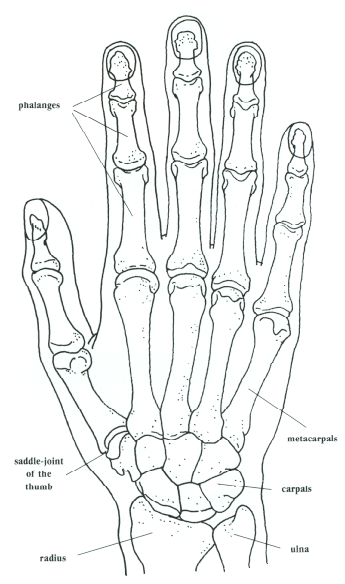|
Each finger of your hand has a row of three bones, called phalanges, running down the center; each thumb has two phalanges. You can easily feel the phalanges by squeezing the fingers of one hand between the index finger and thumb of your other hand.
Your fingers bend at knuckle joints, where the phalanges are held together
by ligaments, muscles, and tendons. Different people can bend each joint
different amounts. Compare the range of motion of your fingers with those
of your friends.
|
|
The major muscles that power your fingers are in your forearm. Watch the underside of your forearm as you curl your flat hand into a fist. You can see the forearm change shape as the muscles contract. Many smaller muscles are located in the hand itself. These small muscles position your fingers precisely so that the major muscles can then apply a larger force. The pad at the base of your thumb contains one such muscle. As you touch your thumb to the tip of your little finger you can use the fingertips of your other hand to feel this muscle tighten. A single long bone, called a metacarpal, connects each finger and thumb to a set of eight bones in the wrist called the carpal bones. By pressing on the back of one hand with the fingers of the other, you can trace these long, straight, metacarpal bones back to where they join the lumpy bones of the wrist. There are eight wrist bones, or carpal bones, which fit together like the pieces of a jigsaw puzzle. They are arranged in two rows of four bones, forming an arch. The tendons which deliver power from the under-the-forearm muscles run through the tunnel under this arch, which is called the carpal tunnel. A band of ligaments stretched across the bottom of the carpal tunnel holds the tendons prisoner. In addition to the tendons, the carpal tunnel is packed with blood vessels and nerves. Make your hand into a fist again while you feel the bottom of your forearm just below the wrist. You should be able to feel tough, straight, cable-like tendons. Wiggle your fingers and thumb and feel the tendons move. |

|
|
As the tendons wend their way from muscles to the phalanges and squeeze through the carpal tunnel, they run in synovial-fluid-lubricated cable guides called tendon sheaths. When the tendons or their sheaths get inflamed from overuse or abuse, the lubrication doesn't work as well. You can feel the tendon grate as it moves. This inflammation contributes to the pain of tendonitis, which is felt by tennis players, climbers, and other people who abuse their hands. The muscles you use when you straighten your hand out of a fist are called extensors, and are located on top of the lower arm. These muscles are connected to the finger bones by tendons that run over the carpal arch and are held in place by bands of ligament. When you make a fist, you see the muscles under your arm bulge; when you straighten your fingers, you can see those on top of your arm move.
Skin, fat, muscle, and bone allow red light to pass through, but the
darker blood in your veins absorbs red light. You can use this absorption
to see the major veins in your hand. In a dark room, hold your hand flat
and shine a flashlight through your hand and fingers. Your hand will glow
red with the easily transmitted part of the white flashlight light. You
will be able to see the dark lines of veins through your hand and along
your fingers.
Now close your eyes. Have your friend choose one of the cards without telling you which one it is. Keep your eyes closed while your friend gently pushes the points of the pins onto your fingertip. Tell your friend how many pins you feel. Have your friend try this with different cards, repeating some so that you can't guess which card is being used. How close together can the pins be and still feel l~e two pins? Repeat this test on the back of your hand, on your forearm, on your neck, and on other parts of your body. Your fingertip has many nerve endings in a small area. Consequently, your fingertip should be able to sense the presence of two pins, when other body parts feel only one. As sensitive as these touch sensors are, there are some things they cannot feel. When you plunge your hand into a bath full of water, you will not be able to feel the uniform pressure squeezing your hand. Like most sensory systems in your body, the tactile sensors of your hand cannot read uniform pressure. However, if you put your hand into a plastic bag and then plunge it underwater, you will be able to feel the pressure of the water. The bag bends the hairs on your hand, pushing them against your skin and causing uneven pressure that can be sensed by your tactile sensors. Shake hands with friends and compare their hands to yours. Before long, you might know as much about hands as Sherlock Holmes himself. |